Variability and Trends in Spring Precipitation in the Central Sector of the Iberian Peninsula (1941–2020): The Central System and Southern Iberian System
Abstract
1. Introduction
2. Materials and Methods
2.1. Study Area
2.2. Climate Data
2.3. Data Integration
2.4. Trend Calculation
3. Results
3.1. General Characterisation of Annual and Spring Precipitation
3.2. Analysis and Characterisation of Annual, Seasonal and Monthly Trends
3.3. Zone Types in Accordance with Trend Analysis
3.4. Geopotential Patterns and Precipitation Trends
4. Discussion and Conclusions
- A general irregularity can be observed in the spring precipitation trends with overall losses at the beginning of spring and an alternation in losses and gains in the months of April and May.
- There is an overall loss in accumulated amounts in the sectors with a marked continentality (Z1, Z2, Z3 and Z4) due to a dependence on a greater or lesser depth of the Atlantic fronts.
- There are gains in the accumulated amounts in the more eastern areas, where the combination of relief and the proximity to the Mediterranean constitute climate-regulating elements, leading to discreet (Z5) and moderate (Z6 and Z7) precipitation increases.
- In general, new patterns of precipitation behaviour are observed with shorter springs with irregular precipitation patterns.
- There is a dominance of overall high pressures (Z500) for a large part of the astronomical spring.
- An alteration is observed in the frequency and continuity of mesoscale situations related to general circulation from the west and a dependence, particularly in the eastern sector, on new reactivation mechanisms on local and regional scales.
Author Contributions
Funding
Data Availability Statement
Conflicts of Interest
References
- Cramer, W.; Guiot, J.; Fader, M.; Garrabou, J.; Gattuso, J.P.; Iglesias, A.; Lange, M.A.; Lionello, P.; Llasat, M.C.; Paz, S.; et al. Climate change and interconnected risks to sustainable development in the Mediterranean. Nat. Clim. Change 2018, 8, 972–980. [Google Scholar] [CrossRef]
- Masson-Delmotte, V.; Zhai, P.; Pirani, A.; Connors, S.L.; Péan, C.; Berger, S.; Caud, N.; Chen, Y.; Goldfarb, L.; Gomis, M.I.; et al. Contribution of Working Group I to the Sixth Assessment Report of the Intergovernmental Panel on Climate Change. In Climate Change: The Physical Science Basis; IPCC: Geneva, Switzerland, 2021. [Google Scholar]
- Meseguer-Ruiz, O.; Olcina Cantos, J. Climate change in two Mediterranean climate areas (Spain and Chile): Evidences and projections. Investig. Geográficas 2023, 79, 9–31. [Google Scholar] [CrossRef]
- AEMET. Atlas Climático Ibérico. In Temperatura del Aire y Precipitación (1971–2000); Ministerio de Medio Ambiente, Medio Rural y Marino: Madrid, Spain, 2011; 79p, Available online: https://www.aemet.es/documentos/es/conocermas/recursos_en_linea/publicaciones_y_estudios/publicaciones/Atlas-climatologico/Atlas.pdf (accessed on 12 November 2024).
- Schmidt, D.F.; Grise, K.M. The response of local precipitation and sea level pressure to Hadley cell expansion. Geophys. Res. Lett. 2017, 44, 10–573. [Google Scholar] [CrossRef]
- Xian, T.; Xia, J.; Wei, W.; Zhang, Z.; Wang, R.; Wang, L.P.; Ma, Y.F. Is Hadley cell expanding? Atmosphere 2021, 12, 1699. [Google Scholar] [CrossRef]
- Cresswell-Clay, N.; Ummenhofer, C.C.; Thatcher, D.L.; Wanamaker, A.D.; Denniston, R.F.; Asmerom, Y.; Polyak, V.J. Twenthieth Century Azores High expansion unprecedented in the last 1200 years. Nat. Geosci. 2022, 15, 548–553. Available online: https://www.nature.com/articles/s41561-022-00971-w (accessed on 12 November 2024). [CrossRef]
- CEDEX. Impacto del Cambio Climático en las Precipitaciones Máximas en España, Madrid; Centro de Estudios Hidrográficos: Madrid, Spain, 2021; 404p. [Google Scholar]
- Cardoso, S.; Martinho, M.A.; Carvalho, A.C.; Rocha, A. Extreme precipitation events under climate change in the Iberian Peninsula. Int. J. Climatol. 2020, 40, 1255–1278. [Google Scholar] [CrossRef]
- Senent-Aparicio, J.; López-Ballesteros, A.; Jimeno-Sáez, P.; Pérez-Sánchez, J. Recent precipitation trends in Peninsular Spain and implications for water infrastructure design. J. Hydrol. Reg. Stud. 2023, 45, 101308. [Google Scholar] [CrossRef]
- Fernández-Martínez, M.; Barquin, J.; Bonada, N.; Cantonati, M.; Churro, C.; Corbera, J.; Delgado, C.; Dulsat-Masvidal, M.; Garcia, G.; Margalef, O.; et al. Mediterranean springs: Keystone ecosystems and biodiversity refugia threatened by global change. Glob. Change Biol. 2024, 30, e16997. [Google Scholar] [CrossRef]
- Zhang, J.; Chen, S.; Wu, Z.; Fu, Y.H. Review of vegetation phenology trends in China in a changing climate. Prog. Phys. Geogr. Earth Environ. 2022, 46, 829–845. [Google Scholar] [CrossRef]
- Li, R.; Xu, X.; Xu, X.; Shepherd, T.G.; Wang, Y. Importance of orographic gravity waves over the Tibetan Plateau on the spring precipitation in East Asia. Sci. China Earth Sci. 2023, 66, 2594–2602. [Google Scholar] [CrossRef]
- Chu, X.; Man, R.; Dang, Q.L. Spring phenology, phenological response, and growing season length. Front. For. Glob. Change 2023, 6, 1041369. [Google Scholar] [CrossRef]
- Bertin, R.I. Plant phenology and distribution in relation to recent climate change. J. Torrey Bot. Soc. 2008, 135, 126–146. [Google Scholar] [CrossRef]
- Ruiz-Sinoga, J.; García-Marín, R.; Martínez Murillo, J.; Gabarrón-Galeote, M. Precipitation dynamics in southern Spain: Trends and cycles. Int. J. Climatol. 2011, 31, 2281–2289. [Google Scholar] [CrossRef]
- Gonzalez-Hidalgo, J.C.; Peña-Angulo, D.; Brunetti, M.; Cortesi, N. Recent trend in temperature evolution in Spanish mainland (1951–2010): From warming to hiatus. Int. J. Climatol. 2016, 36, 2405–2416. [Google Scholar] [CrossRef]
- Gonzalez-Hidalgo, J.C.; Beguería, S.; Peña-Angulo, D.; Trullenque-Blanco, V. MOPREDAS_century database and precipitation trends in mainland Spain, 1916–2020. Int. J. Climatol. 2023, 43, 3828–3840. [Google Scholar] [CrossRef]
- Miró, J.J.; Estrela, M.J.; Olcina-Cantos, J.; Martin-Vide, J. Future Projection of Precipitation Changes in the Júcar and Segura River Basins (Iberian Peninsula) by CMIP5 GCMs Local Downscaling. Atmosphere 2021, 12, 879. [Google Scholar] [CrossRef]
- Miró, J.J.; Estrela, M.J.; Corell, M.; Gómez DIgor Luna, M.Y. Precipitation and drought trends (1952–2021) in a key hydrological recharge area of the eastern Iberian Peninsula. Atmos. Res. 2023, 286, 106695. [Google Scholar] [CrossRef]
- Miró, J.J.; Lemus-Canovas, M.; Serrano-Notivoli, R.; Olcina, J.; Estrela, M.J.; Martin-Vide, J.; Sarricolea, P.; Meseguer-Ruiz, O. A component-based approximation for trend detection of intense precipitation in the Spanish Mediterranean coast. Weather. Clim. Extrem. 2022, 38, 100513. [Google Scholar] [CrossRef]
- Hubálek, Z. Global weather variability affects avian phenology: A long-term analysis, 1881–2001. Folia Zool. 2004, 53, 227–236. [Google Scholar]
- Remisiewicz, M.; Underhill, L.G. Large-scale climatic patterns have stronger carry-over effects than local temperatures on spring phenology of long-distance passerine migrants between Europe and Africa. Animals 2022, 12, 1732. [Google Scholar] [CrossRef]
- Ma, J.; Wang, S.; Deng, T. When the woolly rhinoceroses roamed East Asia: A review of isotopic paleoecology of the genus Coelodonta from the Tibetan Plateau to northern Eurasia. Front. Ecol. Evol. 2024, 12, 1377000. [Google Scholar] [CrossRef]
- Cann, D.J.; Hunt, J.R.; Porker, K.D.; Harris, F.A.; Rattey, A.; Hyles, J. The role of phenology in environmental adaptation of winter wheat. Eur. J. Agron. 2023, 143, 126686. [Google Scholar] [CrossRef]
- Gaona, I.J.A.; Fanzone, M.L.; Galmarini, M.V.; Chirife, J.; Ferreras-Charro, R.; García-Estévez, I.; Escribano-Bailón, M.T. Encapsulation of phenolic compounds by spray drying of Ancellotta and Aspirant Bouchet wines to produce powders with potential use as natural food colorants. Food Biosci. 2022, 50, 102093. [Google Scholar] [CrossRef]
- Capel Molina, J.J. Los sistemas convectivos de mesoescala y su influencia en la España Mediterránea. Papeles Geogr. 2000, 32, 29–43. [Google Scholar]
- Martín Vide, J.; Olcina Cantos, J. Climas y Tiempos de España; Alianza: Madrid, Spain, 2001; 264p. [Google Scholar]
- García Fernández, F. El Clima de la Meseta Meridional: Los Tipos de Tiempo; Del Departamento de Geografía General de la Universidad Autónoma de Madrid: Madrid, Spain, 1985; Volume 3, 215p. [Google Scholar]
- García Fernández, J. El Clima en Castilla y León; Ámbito: Valladolid, Spain, 1986; 370p. [Google Scholar]
- Peral García, M.C.; Navascués, B.; Ramos Calzado, P. Serie de Precipitación Diaria en Rejilla con Fines Climáticos; Notas Técnicas AEMET; AEMET: Madrid, Spain, 2017; Volume 24, 30p. [Google Scholar]
- Hersbach, H.; Brönnimann, S.; Haimberger, L.; Mayer, M.; Villiger, L.; Comeaux, J.; Simmons, A.; Dee, D.; Jourdain, S.; Peubey, C.; et al. The potential value of early (1939–1967) upper-air data in atmospheric climate reanalysis. Q. J. R. Meteorol. Soc. 2017, 143, 1197–1210. [Google Scholar] [CrossRef]
- Babanov, B.A.; Semenov, V.A.; Akperov, M.G.; Mokhov, I.I.; Keenlyside, N.S. Occurrence of Winter Atmospheric Circulation Regimes in Euro-Atlantic Region and Associated Extreme Weather Anomalies in the Northern Hemisphere. Atmos. Ocean. Opt. 2023, 36, 522–531. [Google Scholar] [CrossRef]
- Feliks, Y.; Small, J.; Ghil, M. Global oscillatory modes in high-end climate modeling and reanalyses. Clim. Dyn. 2021, 57, 3385–3411. [Google Scholar] [CrossRef]
- Hu, K.; Fang, X.; Ferrier, K.L.; Granger, D.E.; Zhao, Z.; Ruetenik, G.A. Covariation of cross-divide differences in denudation rate and χ: Implications for drainage basin reorganization in the Qilian Shan, northeast Tibet. Earth Planet. Sci. Lett. 2021, 562, 116812. [Google Scholar] [CrossRef]
- Hamed, K.H.; Rao, A.R. A modified Mann-Kendall trend test for autocorrelated data. J. Hydrol. 1998, 204, 182–196. [Google Scholar] [CrossRef]
- Theil, H. A rank-invariant method of linear and polynomial regression analysis. Indag. Math. 1950, 12, 173. [Google Scholar]
- Sen, P.K. Estimates of the regression coefficient based on Kendall’s tau. J. Am. Stat. Assoc. 1968, 63, 1379–1389. [Google Scholar] [CrossRef]
- Mann, H.B. On the Field of Origin of an Ideal. Can. J. Math. 1950, 2, 16–21. [Google Scholar] [CrossRef]
- Kendall, M.G. Rank Correlation Methods, 4th ed.; Charles Griffin: London, UK, 1975. [Google Scholar] [CrossRef]
- Efon, E.; Ngongang, R.D.; Meukaleuni, C.; Wandjie, B.B.; Zebaze, S.; Lenouo, A.; Valipour, M. Monthly, seasonal, and annual variations of precipitation and runoff over west and Central Africa using remote sensing and climate reanalysis. Earth Syst. Environ. 2023, 7, 67–82. [Google Scholar] [CrossRef]
- Karanja, J.; Svoma, B.M.; Walter, J.; Georgescu, M. Southwest US winter precipitation variability: Reviewing the role of oceanic teleconnections. Environ. Res. Lett. 2023, 18, 053003. [Google Scholar] [CrossRef]
- Luiz-Silva, W.; Oscar-Júnior, A.C. Climate extremes related with rainfall in the State of Rio de Janeiro, Brazil: A review of climatological characteristics and recorded trends. Nat. Hazards 2022, 114, 713–732. [Google Scholar] [CrossRef]
- Tan, J.S.D.; Fischer, A.M. Suggestions for marine protected area management in Australia: A review of temperature trends and management plans. Reg. Environ. Change 2022, 22, 92. [Google Scholar] [CrossRef]
- Deitch, M.J.; Sapundjieff, M.J.; Feirer, S.T. Characterizing Precipitation Variability and Trends in the World’s Mediterranean-Climate Areas. Water 2017, 9, 259. [Google Scholar] [CrossRef]
- Caloiero, T.; Caloiero, P.; Frustaci, F. Long-term precipitation trend analysis in Europe and in the Mediterranean basin. Water Environ. J. 2018, 32, 433–445. [Google Scholar] [CrossRef]
- Acero, F.J.; Gallego, M.C.; García, J.A. Multi-day rainfall trends over the Iberian Peninsula. Theor. Appl. Climatol. 2012, 108, 411–423. [Google Scholar] [CrossRef]
- Serrano, A.; Mateos, V.L.; Garcia, J.A. Trend analysis of monthly precipitation over the iberian peninsula for the period 1921–1995. Phys. Chem. Earth Part B Hydrol. Ocean. Atmos. 1999, 24, 85–90. [Google Scholar] [CrossRef]
- Estrela, M.J.; Corell, D.; Miró, J.J.; Niclós, R. Analysis of Precipitation and Drought in the Main Southeastern Iberian River Headwaters (1952–2021). Atmosphere 2024, 15, 166. [Google Scholar] [CrossRef]
- Liu, Y.; Garcia, M.; Zhang, C.; Tang, Q. Recent decrease in summer precipitation over the Iberian Peninsula closely links to reduction in local moisture recycling. Hydrol. Earth Syst. Sci. 2022, 26, 1925–1936. [Google Scholar] [CrossRef]
- Serrano Notivoli, R. Reconstrucción Climática Instrumental de la Precipitación Diaria en España: Ensayo Metodológico y Aplicaciones. Doctoral Thesis, University of Zaragoza, Zaragoza, Spain, 2017. [Google Scholar]
- Del Río, S.; Penas, Á.; Fraile, R. Analysis of recent climatic variations in Castile and Leon (Spain). Atmos. Res. 2005, 73, 69–85. [Google Scholar] [CrossRef]
- Gonzalez-Hidalgo, J.C.; Brunetti, M.; de Luis, M. Precipitation trends in Spanish hydrological divisions, 1946–2005. Clim. Res 2010, 43, 215–228. [Google Scholar] [CrossRef]
- González-Hidalgo, J.C.; Brunetti, M.; De Luis, M. A new tool for monthly precipitation analysis in Spain: MOPREDAS database (monthly precipitation trends December 1945–November 2005): Monthly precipitation trends in Spain (December 1945–November 2005). Int. J. Clim. 2011, 31, 715–731. [Google Scholar] [CrossRef]
- Paredes, D.; Trigo, R.M.; Garcia-Herrera, R.; Trigo, I.F. Understanding precipitation changes in iberia in early spring: Weather typing and storm-tracking approaches. J. Hydrometeorol. 2006, 7, 101–113. [Google Scholar] [CrossRef]
- Sanchez-Lorenzo, A.; Brunetti, M.; Calbó, J.; Martin-Vide, J. Recent spatial and temporal variability and trends of sunshine duration over the Iberian Peninsula from a homogenized data set. J. Geophys. Res. 2007, 112, D20115. [Google Scholar] [CrossRef]
- Lana, X.; Casas-Castillo, M.C.; Rodríguez-Solà, R.; Prohom, M.; Serra, C.; Martínez, M.D.; Kirchner, R. Time trends, irregularity and multifractal structure on the monthly rainfall regime at Barcelona, NE Spain, years 1786–2019. Int. J. Climatol. 2022, 43, 499–518. [Google Scholar] [CrossRef]
- Gonzalez-Hidalgo, J.C.; Trullenque Blanco, V.; Beguería, S.; Peña-Angulo, D. Seasonal precipitation changes in the western Mediterranean Basin: The case of the Spanish mainland, 1916–2015. Int. J. Climatol. 2024, 44, 5. [Google Scholar] [CrossRef]
- Lorente, C.; Corell, D.; Estrela, M.J.; Miró, J.J.; Orgambides-García, D. Impact of Climate Change on the Bioclimatological Conditions Evolution of Peninsular and Balearic Spain During the 1953–2022 Period. Climate 2024, 12, 183. [Google Scholar] [CrossRef]
- Benetó, P.; Khodayar, S. On the need for improved knowledge on the regional-to-local precipitation variability in eastern Spain under climate change. Atmos. Res. 2023, 290, 106795. [Google Scholar] [CrossRef]
- de la Vara, A.; Cabos, W.; Gutiérrez, C.; Olcina, J.; Matamoros, A.; Pastor, F.; Khodayar, S.; Ferrando, M. Climate change impacts on the tourism sector of the Spanish Mediterranean coast: Medium-term projections for a climate services tool. Clim. Serv. 2024, 34, 100466. [Google Scholar] [CrossRef]
- Mezger, G.; De Stefano, L.; González del Tánago, M. Analysis of the Evolution of Climatic and Hydrological Variables in the Tagus River Basin, Spain. Water 2022, 14, 818. [Google Scholar] [CrossRef]
- Gómez-Martínez, G.; Pérez-Martín, M.A.; Estrela-Monreal, T.; del-Amo, P. North Atlantic Oscillation as a Cause of the Hydrological Changes in the Mediterranean (Júcar River, Spain). Water Resour. Manag. 2018, 32, 2717–2734. [Google Scholar] [CrossRef]
- Alvarez, I.; Pereira, H.; Picado, A.; Sousa, M.C.; Lorenzo, M.N.; Dias, J.M. Projection of Compound Wind and Precipitation Extreme Events in the Iberian Peninsula Based on CMIP6. Earth Syst. Environ. 2024, 8, 801–814. [Google Scholar] [CrossRef]
- Tarín-Carrasco, P.; Petrova, D.; Chica-Castells, L.; Lukovic, J.; Rodó, X.; Cvijanovic, I. Assessment of Future Precipitation Changes in Mediterranean Climate Regions from CMIP6 ensemble. EGUsphere 2024, 1–34. [Google Scholar] [CrossRef]

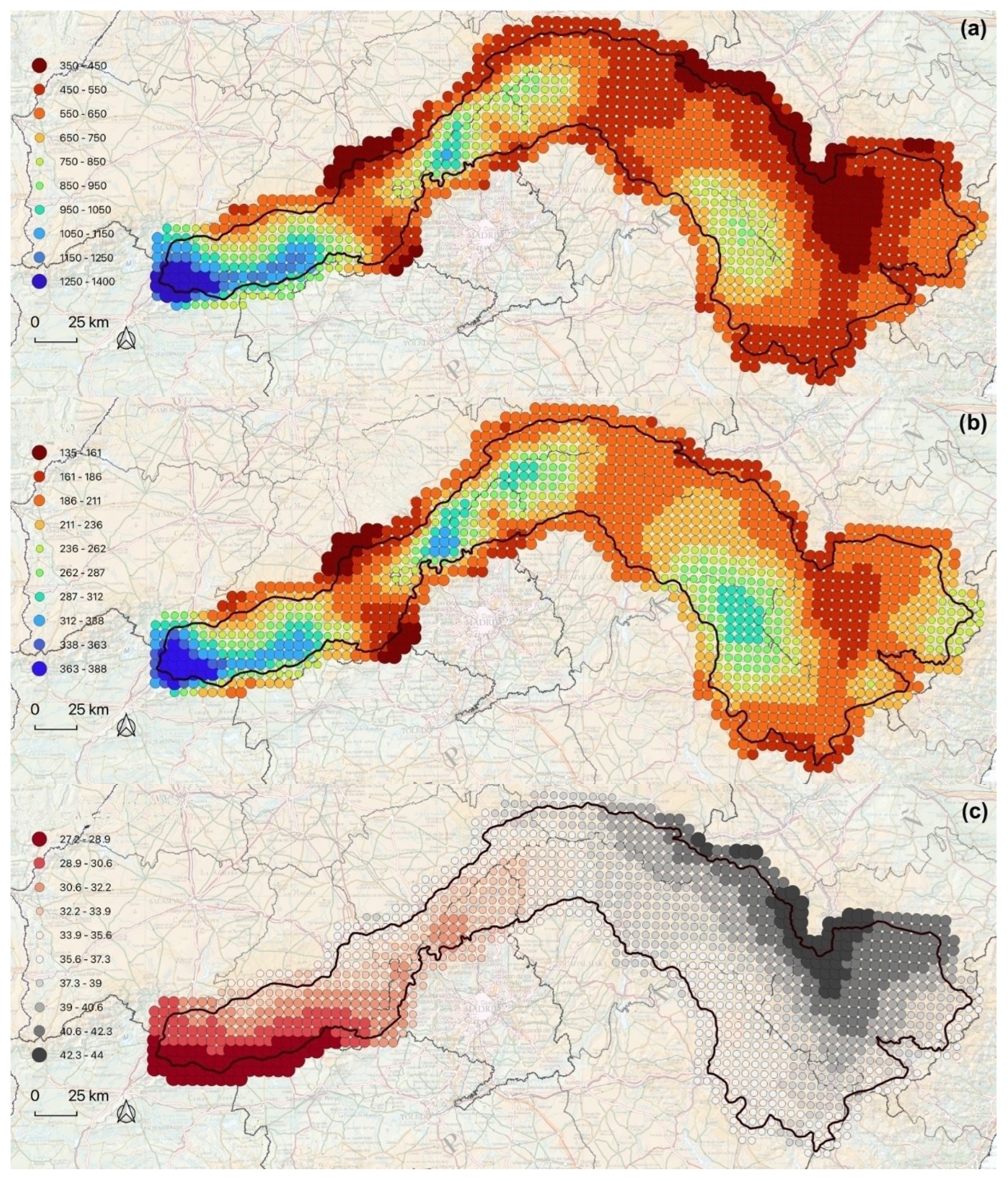
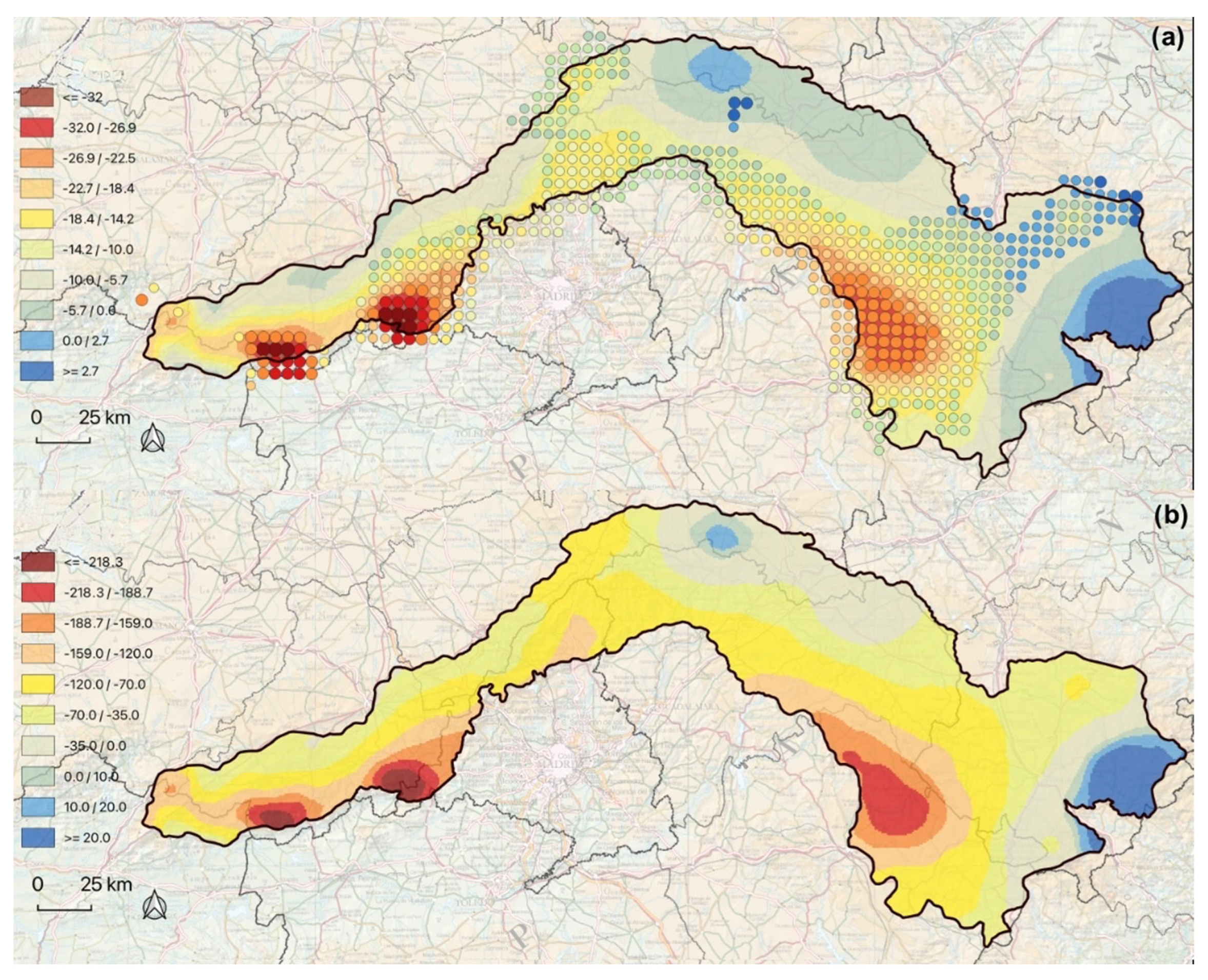
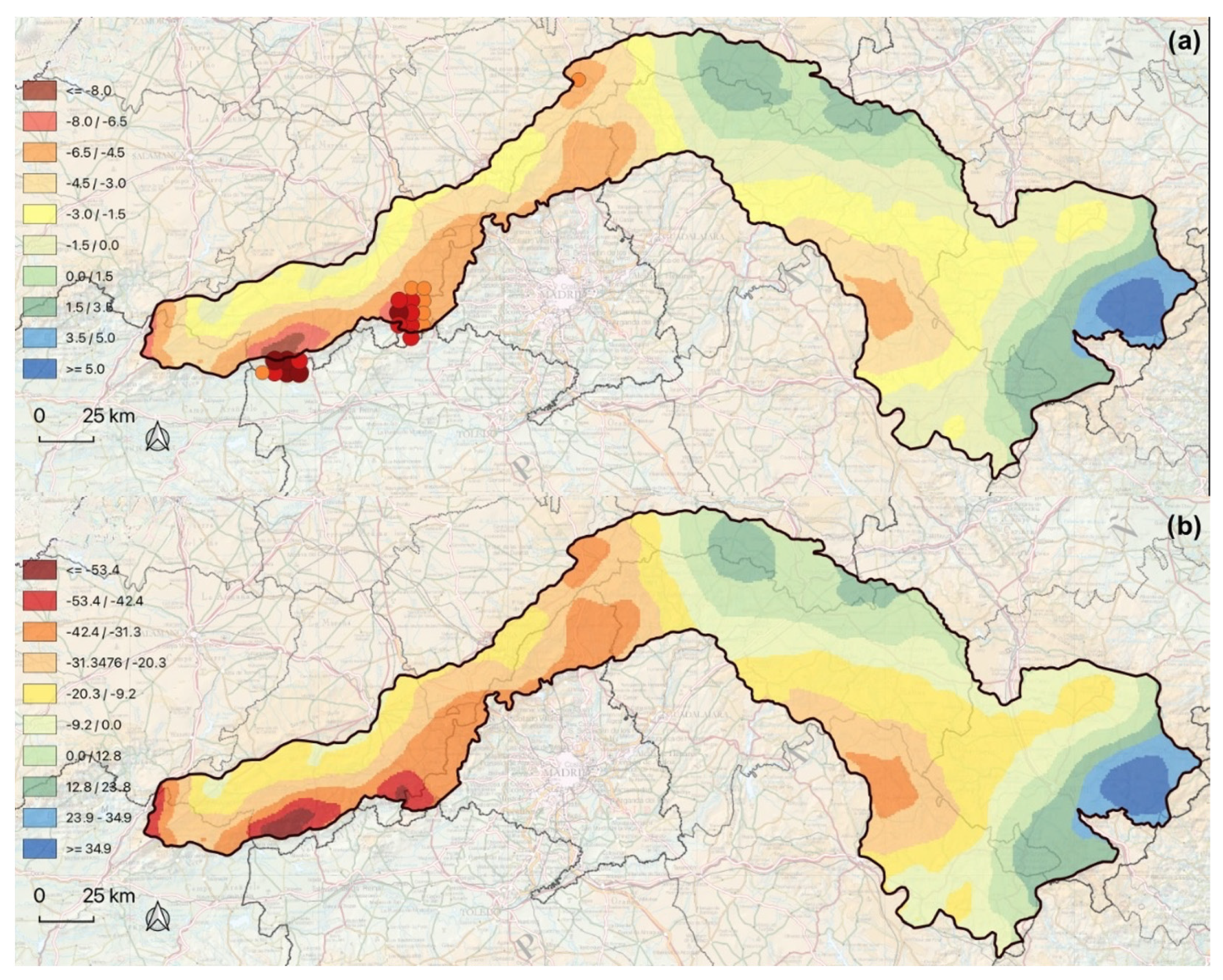
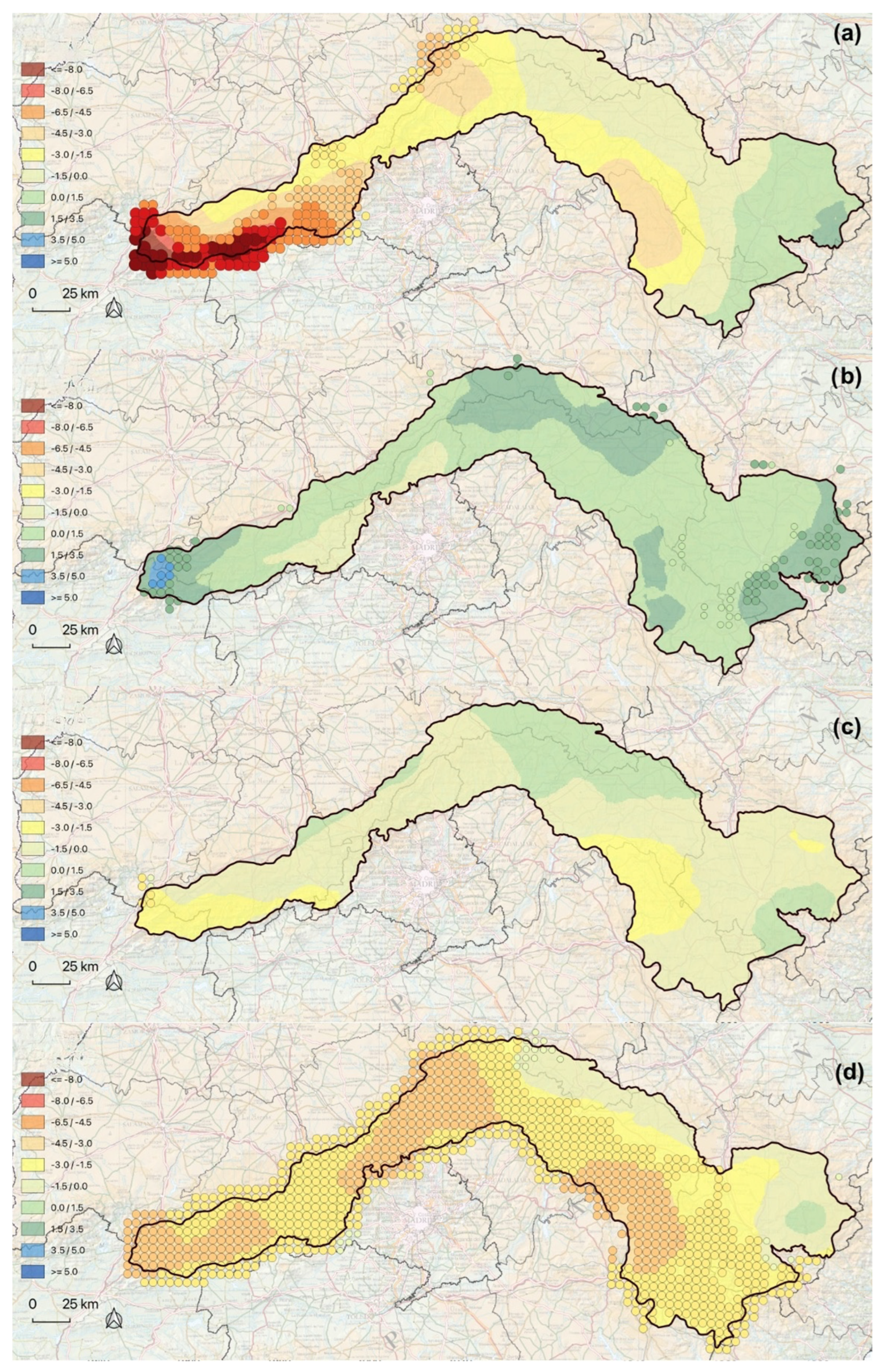
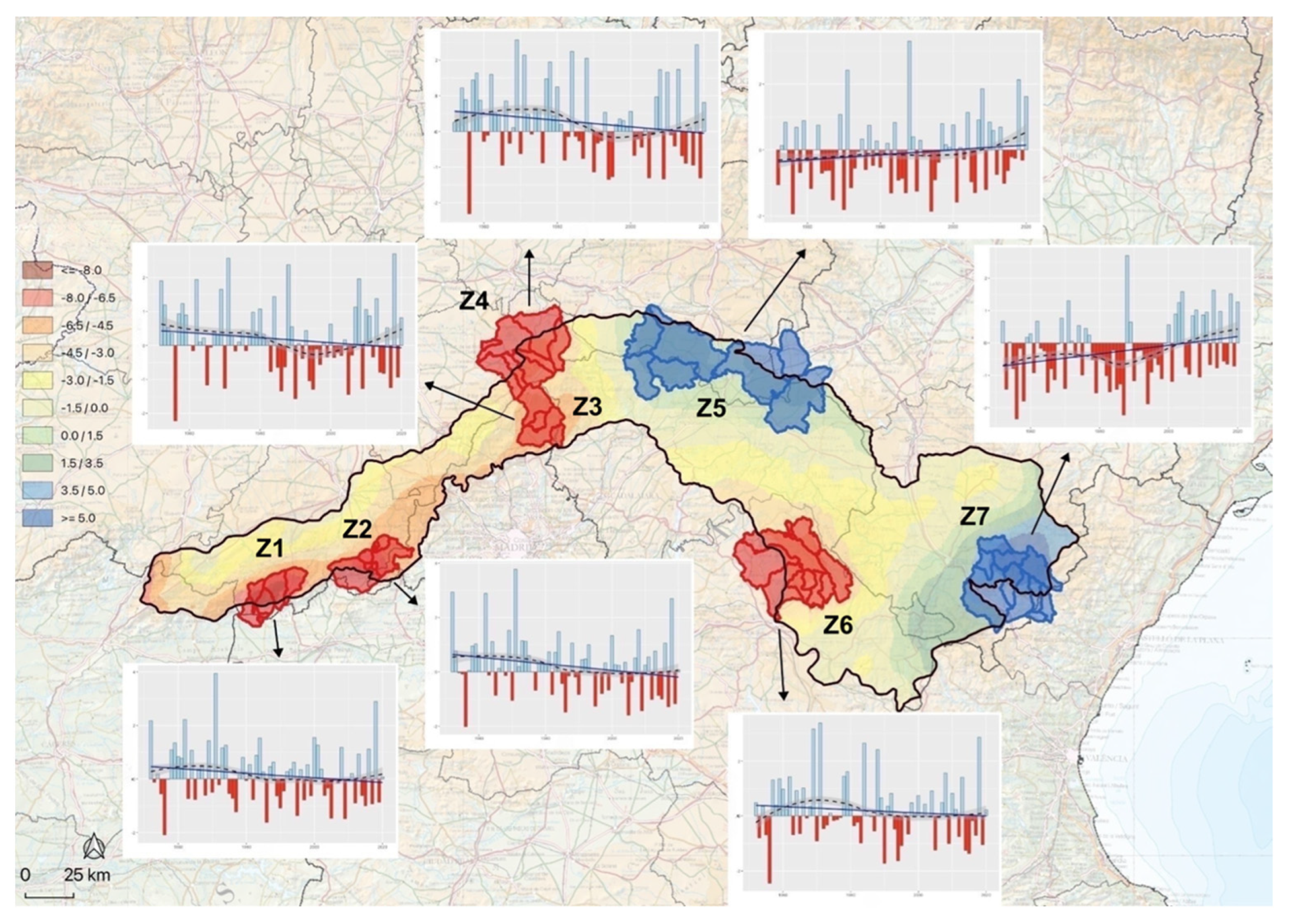
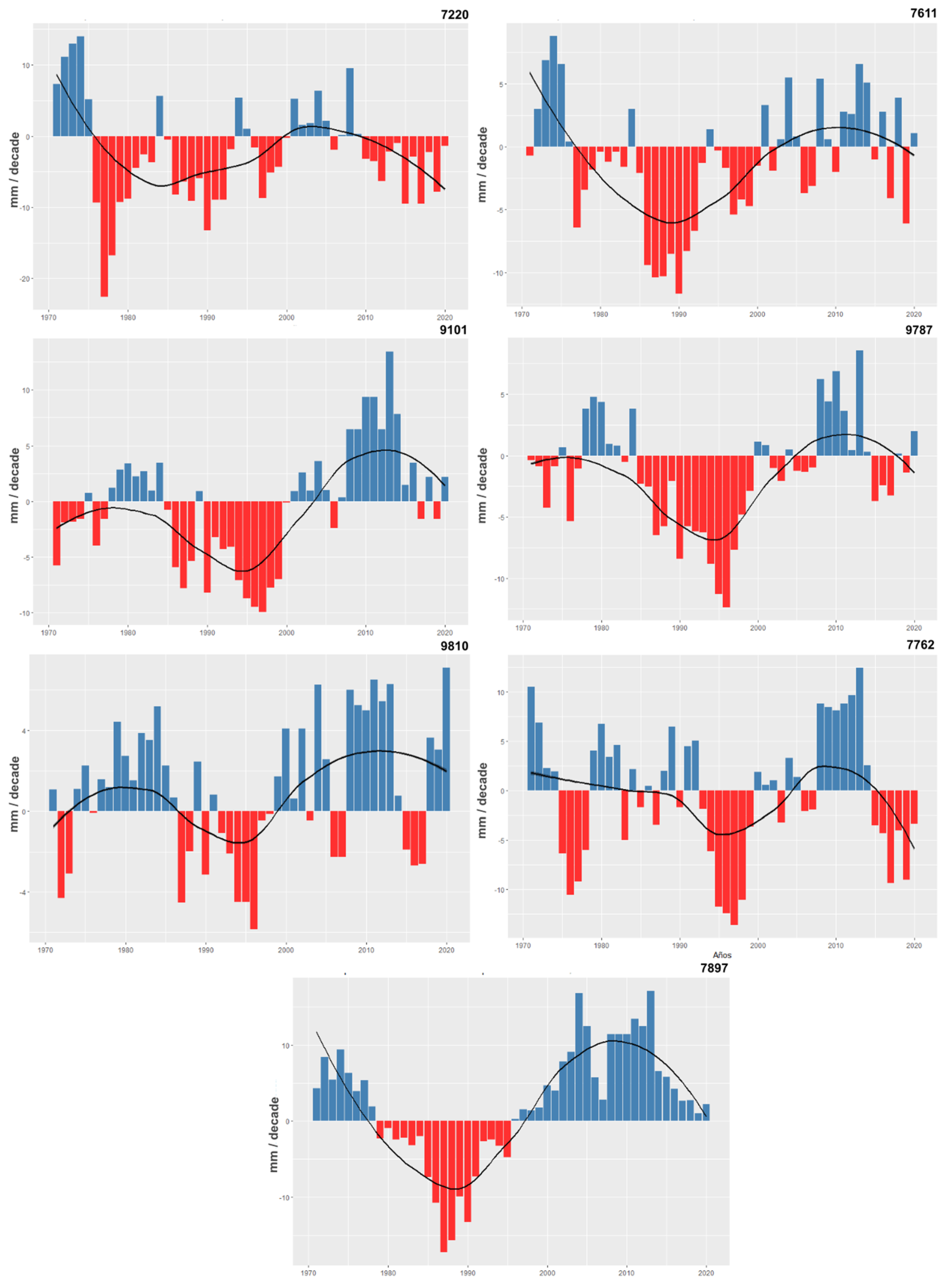

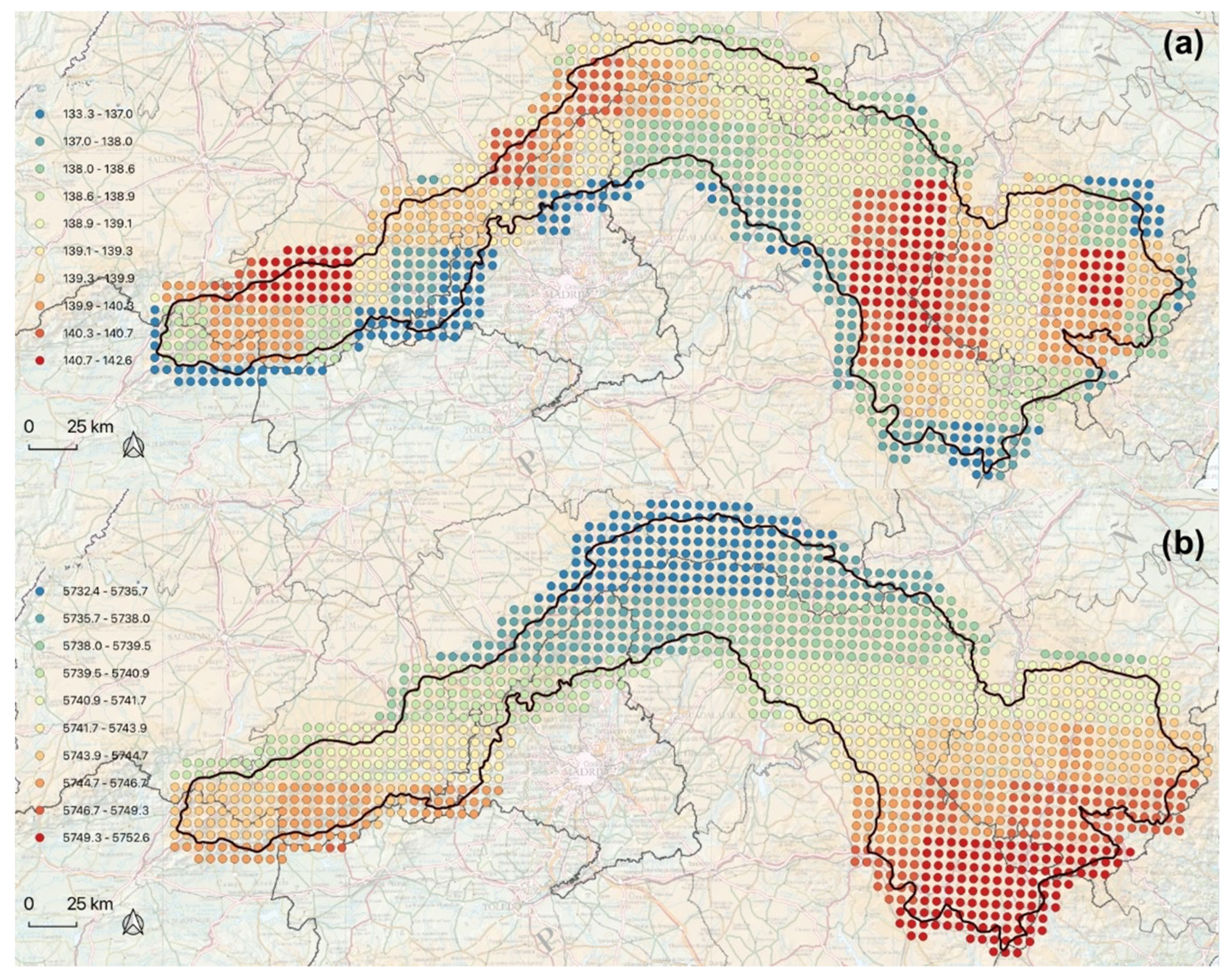
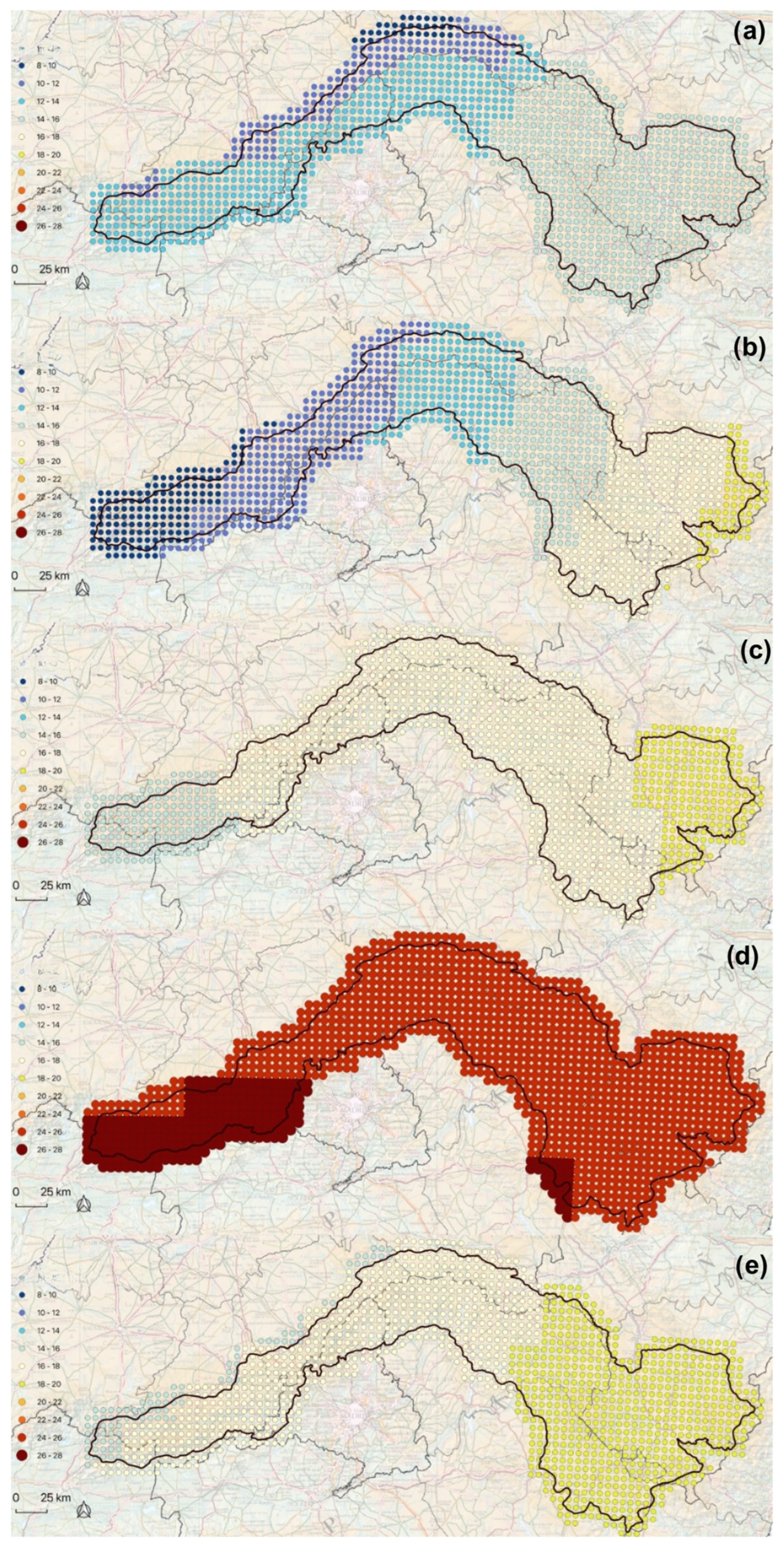

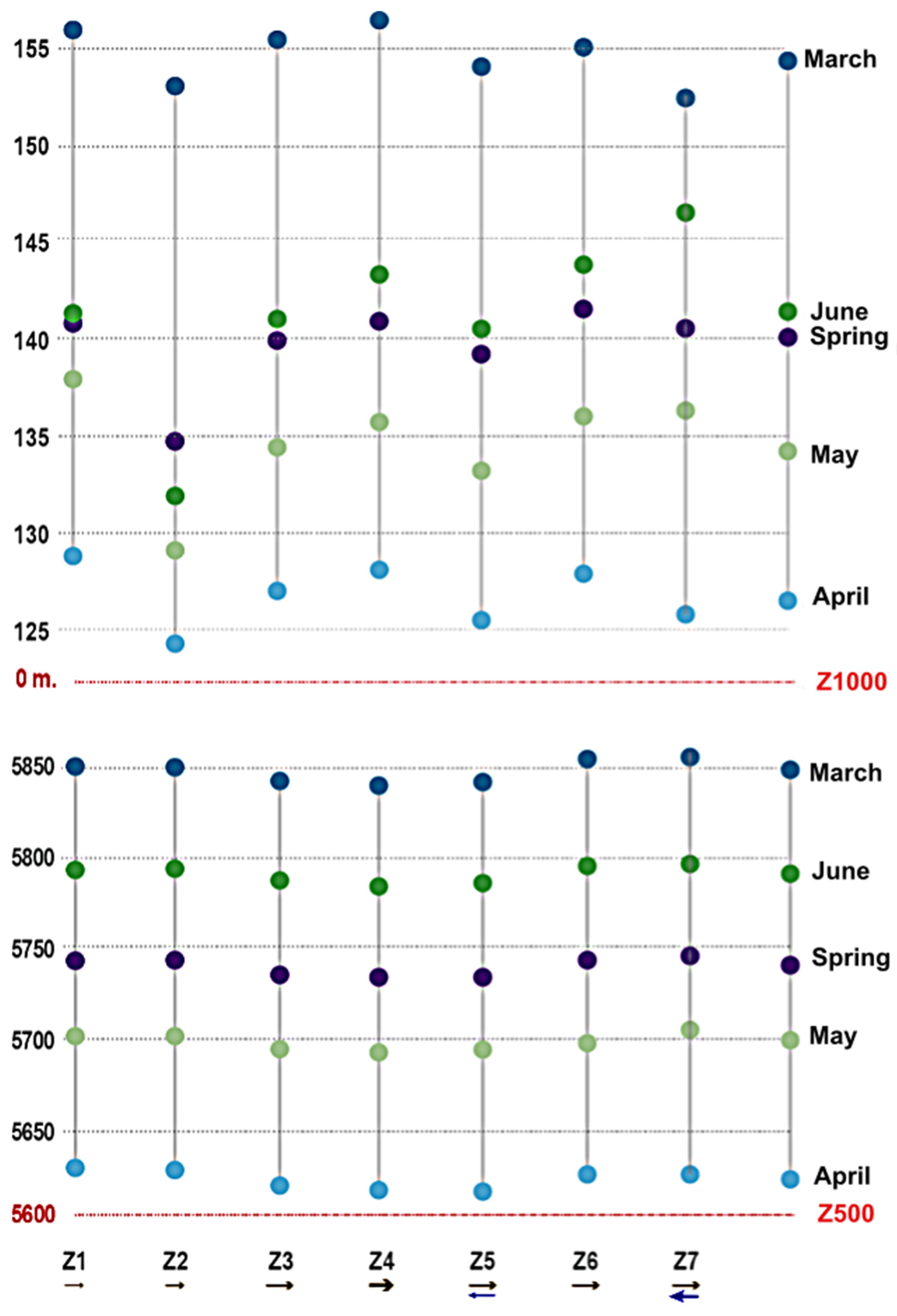
| March | April | May | June | Spring | ||||||
|---|---|---|---|---|---|---|---|---|---|---|
| Z1 | % conv | % lsp | % conv | % lsp | % conv | % lsp | % conv | % lsp | % conv | % lsp |
| 41–70 | 36.6 | 63.4 | 50.5 | 49.5 | 59.2 | 40.8 | 71.3 | 28.7 | 48.8 | 51.2 |
| 51–90 | 29.7 | 70.3 | 48.1 | 51.9 | 56.2 | 43.8 | 69.4 | 30.6 | 44.6 | 55.4 |
| 61–90 | 27.6 | 72.4 | 45.6 | 54.4 | 56.3 | 43.7 | 68.4 | 31.6 | 43.2 | 56.8 |
| 71–00 | 29.3 | 70.7 | 42.5 | 57.5 | 53.2 | 46.8 | 69.8 | 30.2 | 42.0 | 58.0 |
| 81–10 | 33.0 | 67.0 | 41.6 | 58.4 | 55.1 | 44.9 | 72.1 | 27.9 | 43.5 | 56.5 |
| 91–20 | 33.9 | 66.1 | 42.7 | 57.3 | 56.7 | 43.3 | 73.7 | 26.3 | 44.7 | 55.3 |
| Z2 | ||||||||||
| 41–70 | 25.8 | 74.2 | 42.1 | 57.9 | 53.6 | 46.4 | 71.0 | 29.0 | 40.5 | 59.5 |
| 51–90 | 24.3 | 75.7 | 37.7 | 62.3 | 53.7 | 46.3 | 63.3 | 36.7 | 38.6 | 61.4 |
| 61–90 | 24.5 | 75.5 | 37.7 | 62.3 | 53.2 | 46.8 | 69.1 | 30.9 | 38.5 | 61.5 |
| 71–00 | 27.9 | 72.1 | 36.6 | 63.4 | 53.0 | 47 | 68.8 | 31.2 | 39.5 | 60.5 |
| 81–10 | 26.9 | 73.1 | 41.2 | 58.8 | 53.9 | 46.1 | 72.1 | 27.9 | 41.0 | 59.0 |
| 91–20 | 31.4 | 68.6 | 38.8 | 61.2 | 54.7 | 45.3 | 71.7 | 28.3 | 41.9 | 58.1 |
| Z3 | ||||||||||
| 41–70 | 29.2 | 70.8 | 41.7 | 58.3 | 55.1 | 44.9 | 75.3 | 24.7 | 42.0 | 58.0 |
| 51–90 | 27.4 | 72.6 | 40.3 | 59.7 | 55.1 | 44.9 | 69.0 | 31.0 | 40.9 | 59.1 |
| 61–90 | 28.9 | 71.1 | 39.7 | 60.3 | 55.4 | 44.6 | 69.9 | 30.1 | 41.3 | 58.7 |
| 71–00 | 29.9 | 70.1 | 39.4 | 60.6 | 50.8 | 49.2 | 71.4 | 28.6 | 40.0 | 60.0 |
| 81–10 | 31.2 | 68.8 | 40.1 | 59.9 | 52.8 | 47.2 | 73.0 | 27.0 | 41.4 | 58.6 |
| 91–20 | 31.7 | 68.3 | 40.7 | 59.3 | 53.7 | 46.3 | 68.5 | 31.5 | 42.0 | 58.0 |
| Z4 | ||||||||||
| 41–70 | 27.0 | 73.0 | 32.9 | 67.1 | 51.6 | 48.4 | 69.7 | 30.3 | 37.2 | 62.8 |
| 51–90 | 26.5 | 73.5 | 31.4 | 68.6 | 49.1 | 50.9 | 60.6 | 39.4 | 35.7 | 64.3 |
| 61–90 | 25.6 | 74.4 | 33.3 | 66.7 | 51.2 | 48.8 | 60.1 | 39.9 | 36.7 | 63.3 |
| 71–00 | 25.7 | 74.3 | 36.3 | 63.7 | 49.9 | 50.1 | 60.2 | 39.8 | 37.3 | 62.7 |
| 81–10 | 27.0 | 73.0 | 39.0 | 61.0 | 52.1 | 47.9 | 66.3 | 33.7 | 39.4 | 60.6 |
| 91–20 | 28.0 | 72.0 | 40.3 | 59.7 | 50.4 | 49.6 | 68.0 | 32.0 | 39.6 | 60.4 |
| Z5 | ||||||||||
| 41–70 | 19.5 | 80.5 | 24.3 | 75.7 | 38.6 | 61.4 | 48.2 | 51.8 | 27.5 | 72.5 |
| 51–90 | 17.9 | 82.1 | 20.9 | 79.1 | 35.9 | 64.1 | 44.2 | 55.8 | 24.9 | 75.1 |
| 61–90 | 14.2 | 85.8 | 20.0 | 80.0 | 35.6 | 64.4 | 46.6 | 53.4 | 23.2 | 76.8 |
| 71–00 | 13.5 | 86.5 | 22.2 | 77.8 | 36.5 | 63.5 | 47.9 | 52.1 | 24.1 | 75.9 |
| 81–10 | 14.5 | 85.5 | 26.4 | 73.6 | 38.8 | 61.2 | 46.7 | 53.3 | 26.6 | 73.4 |
| 91–20 | 15.0 | 85.0 | 28.2 | 71.8 | 41.9 | 58.1 | 46.2 | 53.8 | 28.4 | 71.6 |
| Z6 | ||||||||||
| 41–70 | 29.3 | 70.7 | 40.9 | 59.1 | 50.3 | 49.7 | 67.7 | 32.3 | 40.1 | 59.9 |
| 51–90 | 26.4 | 73.6 | 39.3 | 60.7 | 49.9 | 50.1 | 59.1 | 40.9 | 38.5 | 61.5 |
| 61–90 | 24.8 | 75.2 | 38.0 | 62.0 | 50.1 | 49.9 | 57.7 | 42.3 | 37.6 | 62.4 |
| 71–00 | 27.4 | 72.6 | 36.6 | 63.4 | 50.8 | 49.2 | 58.9 | 41.1 | 38.3 | 61.7 |
| 81–10 | 30.1 | 69.9 | 41.1 | 58.9 | 52.2 | 47.8 | 63.1 | 36.9 | 41.1 | 58.9 |
| 91–20 | 31.8 | 68.2 | 44.6 | 55.4 | 57.8 | 42.2 | 66.2 | 33.8 | 44.7 | 55.3 |
| Z7 | ||||||||||
| 41–70 | 26.9 | 73.1 | 39.2 | 60.8 | 51.6 | 48.4 | 58.0 | 42.0 | 39.2 | 60.8 |
| 51–90 | 26.5 | 73.5 | 40.1 | 59.9 | 52.5 | 47.5 | 55.8 | 44.2 | 39.7 | 60.3 |
| 61–90 | 26.0 | 74.0 | 37.5 | 62.5 | 52.9 | 47.1 | 54.2 | 45.8 | 38.8 | 61.2 |
| 71–00 | 25.7 | 74.3 | 34.9 | 65.1 | 55.2 | 44.8 | 52.5 | 47.5 | 38.6 | 61.4 |
| 81–10 | 24.6 | 75.4 | 35.2 | 64.8 | 54.4 | 45.6 | 56.9 | 43.1 | 38.1 | 61.9 |
| 91–20 | 24.6 | 75.4 | 36.6 | 63.4 | 52.0 | 48.0 | 64.1 | 35.9 | 37.8 | 62.2 |
| Z1 | Z2 | Z3 | Z4 | Z5 | Z6 | Z7 | Study Area | |
|---|---|---|---|---|---|---|---|---|
| March | −8.05 | −5.18 | −2.63 | −3.13 | −0.62 | −3.55 | 1.44 | −1.88 |
| April | 0.19 | −0.38 | 0.24 | 1.01 | 1.76 | 1.72 | 2.36 | 1.21 |
| May | −2.04 | −1.65 | −0.46 | −0.42 | 1.10 | −2.77 | 0.45 | −0.64 |
| June | −3.31 | −2.35 | −3.08 | −3.63 | −1.06 | −4.39 | −0.18 | −2.32 |
| Spring | −9.24 | −8.04 | −5.81 | −5.39 | 2.91 | −5.30 | 6.57 | −1.50 |
| Annual | −32.10 | −35.34 | −17.35 | −16.51 | −0.80 | −28.65 | 6.97 | −10.98 |
| March | April | May | June | Spring | |
|---|---|---|---|---|---|
| Z500 m | |||||
| Z1 | 5850.6 | 5631.5 | 5703.0 | 5795.1 | 5745.1 |
| Z2 | 5851.0 | 5630.2 | 5703.0 | 5795.1 | 5744.8 |
| Z3 | 5843.7 | 5621.9 | 5697.0 | 5788.5 | 5737.8 |
| Z4 | 5840.6 | 5619.3 | 5694.6 | 5785.9 | 5735.1 |
| Z5 | 5842.5 | 5618.5 | 5696.2 | 5787.1 | 5736.1 |
| Z6 | 5855.1 | 5628.4 | 5700.3 | 5797.6 | 5745.4 |
| Z7 | 5856.4 | 5627.9 | 5707.0 | 5798.3 | 5747.4 |
| Area of study | 5849.1 | 5625.2 | 5701.3 | 5792.8 | 5742.1 |
| Z1000 m | |||||
| Z1 | 155.8 | 128.7 | 137.8 | 141.2 | 140.9 |
| Z2 | 152.9 | 124.2 | 129.0 | 131.8 | 134.5 |
| Z3 | 155.3 | 126.9 | 134.3 | 140.9 | 139.4 |
| Z4 | 156.3 | 128.0 | 135.6 | 143.2 | 140.8 |
| Z5 | 153.9 | 125.4 | 133.1 | 140.4 | 138.2 |
| Z6 | 154.9 | 127.8 | 135.9 | 143.7 | 140.6 |
| Z7 | 152.3 | 125.7 | 136.2 | 146.4 | 140.2 |
| Area of study | 154.2 | 126.4 | 134.1 | 141.3 | 139.0 |
| March | April | May | June | Spring | |
|---|---|---|---|---|---|
| P vs. Z500 | |||||
| Z1 | −0.07 | −0.21 | −0.43 | −0.79 | −0.22 |
| Z2 | −0.20 | −0.24 | −0.49 | −0.75 | −0.34 |
| Z3 | −0.23 | 0.10 | −0.56 | −0.64 | −0.31 |
| Z4 | −0.24 | 0.04 | −0.44 | −0.73 | −0.34 |
| Z5 | 0.02 | −0.02 | −0.28 | −0.72 | −0.12 |
| Z6 | −0.12 | 0.14 | −0.74 | −0.74 | −0.51 |
| Z7 | 0.36 | 0.46 | −0.24 | −0.27 | 0.38 |
| P vs. Z1000 | |||||
| Z1 | −0.86 | −0.23 | −0.49 | 0.04 | −0.54 |
| Z2 | −0.81 | −0.17 | −0.46 | 0.21 | −0.34 |
| Z3 | −0.78 | −0.12 | −0.67 | 0.27 | −0.65 |
| Z4 | −0.82 | −0.24 | −0.55 | 0.09 | −0.51 |
| Z5 | −0.73 | −0.55 | −0.55 | −0.25 | −0.41 |
| Z6 | −0.81 | −0.18 | −0.68 | 0.19 | −0.51 |
| Z7 | −0.22 | −0.36 | −0.37 | −0.23 | −0.25 |
| March | April | May | June | Spring | |
|---|---|---|---|---|---|
| m/decade Z500 | |||||
| Z1 | 2.43 | 3.20 | 6.49 | 3.63 | 7.51 |
| Z2 | 2.45 | 4.01 | 6.81 | 3.56 | 7.39 |
| Z3 | 2.63 | 7.14 | 6.88 | 3.17 | 7.17 |
| Z4 | 2.68 | 5.73 | 6.20 | 3.09 | 7.41 |
| Z5 | 2.72 | 6.63 | 6.57 | 3.36 | 7.09 |
| Z6 | 2.59 | 6.24 | 6.21 | 3.57 | 6.56 |
| Z7 | 2.65 | 5.36 | 4.58 | 3.69 | 6.05 |
| m/decade Z1000 | |||||
| Z1 | 3.73 | −0.80 | 1.62 | −0.25 | 0.49 |
| Z2 | 3.76 | −0.98 | 1.48 | −0.36 | 0.42 |
| Z3 | 4.12 | −1.25 | 1.98 | −0.42 | 0.32 |
| Z4 | 4.05 | −1.31 | 1.73 | −0.39 | 0.37 |
| Z5 | 4.20 | −1.56 | 2.04 | −0.76 | 0.18 |
| Z6 | 4.60 | −0.44 | 2.82 | −0.37 | 0.20 |
| Z7 | 4.18 | −0.30 | 2.72 | −0.18 | 0.60 |
| Sector Analysed | Annual Precipitation Trends (mm/decade) | Springs Precipitation Trends (mm/decade) |
|---|---|---|
| Z1 | −9.24 | −32.10 * |
| Z2 | −8.04 * | −35.34 * |
| Z3 | −5.81 | −17.35 * |
| Z4 | −5.39 * | −16.51 * |
| Z5 | 2.91 | −0.80 |
| Z6 | −5.30 | −28.65 * |
| Z7 | 6.57 | 6.97 |
| Study area | −1.50 | −10.98 |
Disclaimer/Publisher’s Note: The statements, opinions and data contained in all publications are solely those of the individual author(s) and contributor(s) and not of MDPI and/or the editor(s). MDPI and/or the editor(s) disclaim responsibility for any injury to people or property resulting from any ideas, methods, instructions or products referred to in the content. |
© 2025 by the authors. Licensee MDPI, Basel, Switzerland. This article is an open access article distributed under the terms and conditions of the Creative Commons Attribution (CC BY) license (https://creativecommons.org/licenses/by/4.0/).
Share and Cite
Espín-Sánchez, D.; Allende-Álvarez, F.; López-Estébanez, N.; Olcina-Cantos, J. Variability and Trends in Spring Precipitation in the Central Sector of the Iberian Peninsula (1941–2020): The Central System and Southern Iberian System. Climate 2025, 13, 122. https://doi.org/10.3390/cli13060122
Espín-Sánchez D, Allende-Álvarez F, López-Estébanez N, Olcina-Cantos J. Variability and Trends in Spring Precipitation in the Central Sector of the Iberian Peninsula (1941–2020): The Central System and Southern Iberian System. Climate. 2025; 13(6):122. https://doi.org/10.3390/cli13060122
Chicago/Turabian StyleEspín-Sánchez, David, Fernando Allende-Álvarez, Nieves López-Estébanez, and Jorge Olcina-Cantos. 2025. "Variability and Trends in Spring Precipitation in the Central Sector of the Iberian Peninsula (1941–2020): The Central System and Southern Iberian System" Climate 13, no. 6: 122. https://doi.org/10.3390/cli13060122
APA StyleEspín-Sánchez, D., Allende-Álvarez, F., López-Estébanez, N., & Olcina-Cantos, J. (2025). Variability and Trends in Spring Precipitation in the Central Sector of the Iberian Peninsula (1941–2020): The Central System and Southern Iberian System. Climate, 13(6), 122. https://doi.org/10.3390/cli13060122









